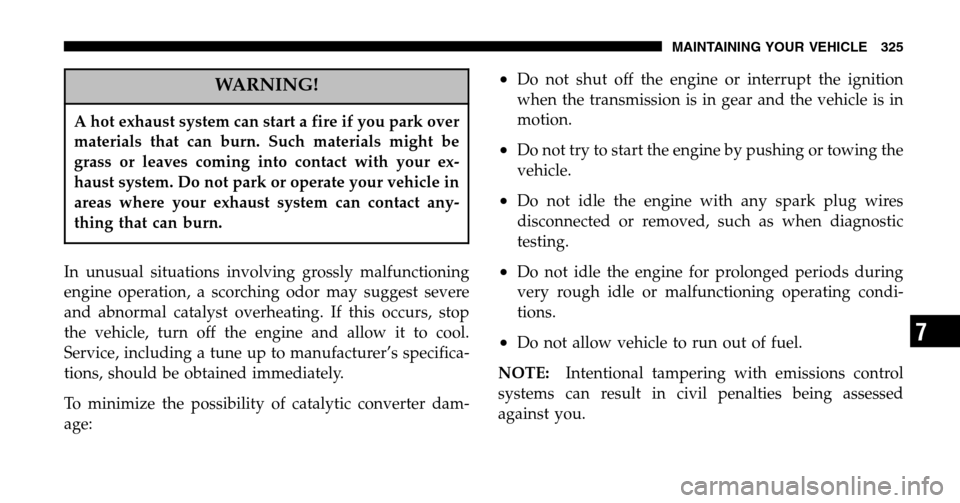Page 312 of 424

▫Driveline And Steering Component
Lubrication ..........................329
▫ Body Lubrication .....................329
▫ Windshield Wiper Blades ................330
▫ Windshield Washers ...................330
▫ Exhaust System ......................331
▫ Cooling System .......................332
▫ Hoses And Vacuum/Vapor Harnesses .......337
▫ Brake System ........................337
▫ Automatic Transmission ................340
▫ Hydraulic Clutch Fluid —
Manual Transmission ..................342
▫ Manual Transmission ..................342
▫ Transfer Case ........................342 ▫
Front/Rear Axle Fluid ..................343
▫ Appearance Care And Protection From
Corrosion ...........................345
� Fuse Panel ...........................349
▫ Interior Fuses ........................349
▫ Underhood Fuses
(Power Distribution Center) ..............351
� Vehicle Storage ........................355
� Replacement Bulbs ......................356
� Bulb Replacement ......................356
▫ Head Light ..........................356
▫ Front Turn Signal .....................357
▫ Front Fog Light (Front Fascia Mounted) .....358
▫ Light Bar ...........................359
312 MAINTAINING YOUR VEHICLE
Page 316 of 424

ONBOARD DIAGNOSTIC SYSTEM — OBD II
Your vehicle is equipped with a sophisticated onboard
diagnostic system called OBD II. This system monitors
the performance of the emissions, engine, and automatic
transmission control systems. When these systems are
operating properly, your vehicle will provide excellent
performance and fuel economy, as well as engine emis-
sions well within current government regulations.
If any of these systems require service, the OBD II system
will turn on the “Malfunction Indicator Light.” It will
also store diagnostic codes and other information to
assist your service technician in making repairs. Al-
though your vehicle will usually be drivable and not
need towing, see your dealer for service as soon as
possible.CAUTION!
•Prolonged driving with the “Malfunction Indica-
tor Light” on could cause further damage to the
emission control system. It could also affect fuel
economy and driveability. The vehicle must be
serviced before any emissions tests can be per-
formed.
•If the “Malfunction Indicator Light” is flashing
while the engine is running, severe catalytic con-
verter damage and power loss will soon occur.
Immediate service is required.
Loose Fuel Filler Cap Message
If the vehicle diagnostic system determines that the fuel
filler cap is loose, improperly installed, or damaged, a
“GAS CAP” message will be displayed in the odometer
(located on the instrument cluster). Replace, or tighten
316 MAINTAINING YOUR VEHICLE
Page 325 of 424

WARNING!
A hot exhaust system can start a fire if you park over
materials that can burn. Such materials might be
grass or leaves coming into contact with your ex-
haust system. Do not park or operate your vehicle in
areas where your exhaust system can contact any-
thing that can burn.
In unusual situations involving grossly malfunctioning
engine operation, a scorching odor may suggest severe
and abnormal catalyst overheating. If this occurs, stop
the vehicle, turn off the engine and allow it to cool.
Service, including a tune up to manufacturer’s specifica-
tions, should be obtained immediately.
To minimize the possibility of catalytic converter dam-
age:
•Do not shut off the engine or interrupt the ignition
when the transmission is in gear and the vehicle is in
motion.
•Do not try to start the engine by pushing or towing the
vehicle.
•Do not idle the engine with any spark plug wires
disconnected or removed, such as when diagnostic
testing.
•Do not idle the engine for prolonged periods during
very rough idle or malfunctioning operating condi-
tions.
•Do not allow vehicle to run out of fuel.
NOTE: Intentional tampering with emissions control
systems can result in civil penalties being assessed
against you.
MAINTAINING YOUR VEHICLE 325
7
Page 340 of 424

Use only brake fluid that has been in a tightly closed
container to avoid contamination from foreign matter. Do
not allow petroleum base fluid to contaminate the brake
fluid as seal damage will result.
Automatic Transmission
Selection of Lubricant
It is important that the proper lubricant is used in the
transmission to assure optimum transmission perfor-
mance. Use only manufacturer’s recommended transmis-
sion fluid, refer to Fluids, Lubricants, and Genuine Parts
for correct fluid type. It is important that the transmission
fluid be maintained at the prescribed level using the
recommended fluid.
CAUTION!
Using a transmission fluid other than the manufac-
turer’s recommended fluid may cause deterioration
in transmission shift quality and/or torque converter
shudder. Using a transmission fluid other than the
manufacturer’s recommended fluid will result in
more frequent fluid and filter changes. Refer to
Fluids, Lubricants, and Genuine Parts for correct
fluid type.
Fluid Level Check – 3.7L Gasoline Engine (42RLE)
and 2.8L Diesel Engine (545RFE)
This fluid level should be checked when the engine is
fully warmed up and the fluid in the transmission is
heated to its normal operating temperature. Operation of
the transmission with an improper fluid level will greatly
reduce the life of the transmission and of the fluid.
340 MAINTAINING YOUR VEHICLE
Page 341 of 424

To check the automatic transmission fluid level properly,
the following procedure must be used:
1. The vehicle must be on level ground.
2. The engine should be running at curb idle speed for a
minimum of 60 seconds.
3. Fully apply parking brake.
4. Apply the brakes and shift the transmission into P
(Park).
5. The fluid MUSTbe checked with the transmission in
P (Park) to be sure that the fluid level is accurate.
6. Wipe the dipstick clean and reinsert until seated.
Remove dipstick and note reading.
At normal operating temperature (approximately 180° F
(82° C), the fluid level is correct if it is in the HOT region (cross-hatched area) on the oil level indicator. The fluid
level indicator should be in the COLD region at 70° F (21°
C) fluid temperature.
If the fluid level is low, add sufficient fluid to bring to the
proper level. Refer to Fluids, Lubricants and Genuine
Parts for correct fluid type.
Fluid is added through the dipstick tube.
NOTE:
To prevent dirt and water from entering the
transmission after checking or replenishing fluid, make
certain that the dipstick cap is properly reseated.
Special Additives
The manufacturer recommends against the addition of
any additives to the transmission. Exception to this
policy is the use of special dyes to aid in detecting fluid
leaks.
MAINTAINING YOUR VEHICLE 341
7
Page 342 of 424

Hydraulic Clutch Fluid — Manual Transmission
The clutch hydraulic system is a sealed maintenance free
system. In the event of leakage or other malfunction, the
system must be replaced.
Manual Transmission
Selection of Lubricant
Use only manufacturer’s recommended manual trans-
mission fluid, refer to Fluids, Lubricants, and Genuine
Parts for correct fluid type.
Fluid Level Check
Check the fluid level by removing the fill plug. The fluid
level should be between the bottom of the fill hole and a
point not more than 3/16” (4.76 mm) below the bottom of
the hole.
Add fluid, if necessary, to maintain the proper level.
Frequency of Fluid Change
Under normal operating conditions, the fluid installed at
the factory will give satisfactory lubrication for the life of
the vehicle. Fluid changes are not necessary unless the
lubricant has become contaminated with water. If con-
taminated with water, the fluid should be changed im-
mediately.
Transfer Case
Fluid Level Check
Inspect the transfer case for fluid leaks. If a fluid leak is
evident, the transfer case fluid level can be checked by
removing the fill plug (B) located at the back of the
transfer case.
The fluid level should be to the bottom edge of the fill
hole (A) when the vehicle is in a level position.
342 MAINTAINING YOUR VEHICLE
Page 350 of 424

Cavity Fuse Description
13 10 Amp Red Body Control Module/ CMTC/Cluster/Pass. Airbag
On,Off Indicator, Auto Day-
light Mirror/Light Bar
Switch (Renegade Only)
14 10 Amp Red PDC Fuel Pump/AC Clutch, Starter Relay/Engine
Controller/Transmission
Controller (Diesel Only)
15 Spare
16 20 Amp Yellow Power Outlet (Rear)
17 15 Amp Blue Rear Wiper
18 20 Amp Yellow Radio Choke & Relay
19 20 Amp Yellow Frt Fog Lights/Trailer Tow Stop and Turn Lights
20 Spare
21 10 Amp Red RadioCavity Fuse Description
22 20 Amp Yellow Power Sunroof Relay/ Antenna Module (Export
Only)
23 Spare
24 10 Amp Red PDC Blower Motor
25 10 Amp Red Heated Seat Switches/HVAC Control Head/Trailer Tow
Battery Charge
26 10 Amp Red Headlight High Beam Right
27 10 Amp Red Headlight High Beam Left
28 Spare
29 10 Amp Red Heated Mirrors/Rear Win- dow Defroster Indicator
30 15 Amp Blue Heated Seat Module
31 Spare
32 10 Amp Red Wiper Switch/Front and Rear Wipers
33 10 Amp Red SKIM Module/Data Link Connector
350 MAINTAINING YOUR VEHICLE
Page 351 of 424

Cavity Fuse Description
34 15 Amp Blue Body Control Module/ Cluster/Interior Lights,
Hands Free Module/Radio/
CMTC/ITM Module & Siren
(Export Only)
35 Spare
36 10 Amp Red Airbag Control Module/ Occupation Classification
Module (Right Front Seat)
37 10 Amp Red Airbag Control Module
38 10 Amp Red ABS Controller/Shifter As- sembly
39 10 Amp Red Hazard Flasher (Turn Signals)/Backup Lamp
Switch (Manual Transmission
Only)/Transmission Range
Switch (Automatic Transmis-
sion Only)Underhood Fuses (Power Distribution Center)
Your vehicle is equipped with an electrical power distri-
bution center located in the engine compartment near the
battery. This power center houses plug-in “Cartridge”
fuses which replace in-line fusible links. The power
center also contains “Mini” fuses and plug-in full and
micro ISO relays. A label inside the latching cover of the
center identifies each component for ease of replacement,
if necessary. “Cartridge” fuses and relays can be obtained
from your authorized dealer.
MAINTAINING YOUR VEHICLE 351
7